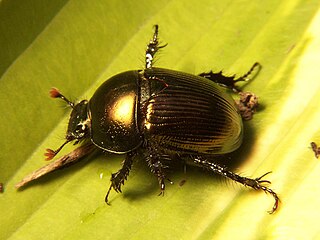
Scarabaeoidea is a superfamily of beetles, the only subgroup of the infraorder Scarabaeiformia. Around 35,000 species are placed in this superfamily and some 200 new species are described each year. Its constituent families are also undergoing revision presently, and the family list below is only preliminary. This superfamily includes some of the largest beetles extant today, including rhinoceros beetles, (Dynastinae), the Hercules beetle and Goliath beetles.

Geotrupidae is a family of beetles in the order Coleoptera. They are commonly called earth-boring dung beetles or dor beetles. Most excavate burrows in which to lay their eggs. They are typically detritivores, provisioning their nests with leaf litter, but are occasionally coprophagous, similar to dung beetles. The eggs are laid in or upon the provision mass and buried, and the developing larvae feed upon the provisions. The burrows of some species can exceed 2 metres in depth.

Ochodaeidae, also known as the sand-loving scarab beetles, is a small family of scarabaeiform beetles occurring in many parts of the world.

Geotrupes is a genus of earth-boring scarab beetles in the family Geotrupidae. There are at least 30 described species in Geotrupes.

Anobiinae is a subfamily of death-watch beetles in the family Ptinidae, with at least 45 genera. It was formerly considered a member of the family Anobiidae, but its family name has since been changed to Ptinidae.

Ataenius is a genus of aphodiine dung beetles in the family Scarabaeidae. There are at least 290 described species in Ataenius.
Canthidium is a genus of dung beetles in the family Scarabaeidae. There are at least 170 described species in Canthidium.

Hoplia is a genus of monkey beetles in the family Scarabaeidae. There are at least 300 described species in Hoplia. These species are found in Asia, Europe, South Africa, Madagascar, and the Americas.

Aegialiinae is a small subfamily of the family Scarabaeidae. Historically the group has been treated as a tribe within a broad definition of the subfamily Aphodiinae.
Diplotaxis frondicola is a species of May beetle or junebug in the family Scarabaeidae. It is found in North America.
Hoplia sackenii is a species of May beetle or junebug in the family Scarabaeidae. It is found in North America.
Copris remotus is a species of dung beetle in the family Scarabaeidae.

Bolboceratinae is a subfamily of earth-boring scarab beetles in the family Geotrupidae. There are about 8 genera and at least 40 described species in Bolboceratinae.
Hypotrichia is a genus of May beetles and junebugs in the family Scarabaeidae. There is at least one described species in Hypotrichia, H. spissipes.
Pachyplectrinae is a subfamily of thick scavenger scarab beetles in the family Hybosoridae. There is at least one genus, Pachyplectrus, in Pachyplectrinae.

Ateuchini is a tribe of dung beetles in the family Scarabaeidae. There are at least 30 genera and 370 described species in Ateuchini.
Podolasiini is a tribe of May beetles and junebugs in the family Scarabaeidae. There are at least 2 genera and about 18 described species in Podolasiini.

Hybosorinae is a subfamily of scavenger scarab beetles in the family Hybosoridae. There is at least one extant genus, Hybosorus, in Hybosorinae, and several extinct genera.

Ceratophyus is a genus of earth-boring scarab beetles in the family Geotrupidae. There are about 13 described species in Ceratophyus.
Gymnetina is a genus of fruit and flower chafers in the family of beetles known as Scarabaeidae. There are about six described species in Gymnetina.













